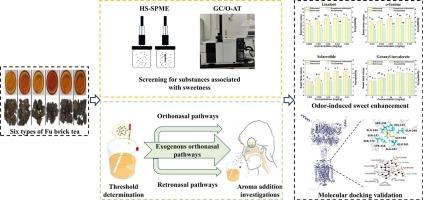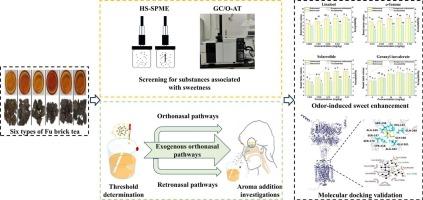跨模态香气-味觉相互作用对茯砖茶甜味感知增强的机理研究
IF 9.8
1区 农林科学
Q1 CHEMISTRY, APPLIED
引用次数: 0
摘要
不断增长的饮料减糖需求需要创新的方法来保持甜味感知而不影响可接受性。采用顶空固相微萃取法(HS-SPME)结合气相色谱/嗅觉相关味法(GC/O-AT)对茯砖茶(FBT)中的挥发性成分进行了分析,鉴定出4种主要的甜味相关香气成分。阈值测定与梯度单体重组实验相结合,量化了化合物对甜度的贡献。感官评价显示α-离子酮、芳樟醇和核核内酯是较好的增强剂,其中α-离子酮表现出最佳的效力和适口性。分子对接模拟表明,T1R2/T1R3结合能分别为−7.0 kcal/mol (sclareolide)、−6.2 kcal/mol (α-ionone)、−5.8 kcal/mol(异戊酸香叶基)和 − 5.0 kcal/mol(芳樟醇)。然而,结合能大小与感觉增强缺乏绝对相关性。分子动力学模拟进一步证实了主要由氢键和疏水力介导的稳定的配体-受体复合物。本研究阐明了跨模态的香气-味觉相互作用是FBT中甜味感知的关键驱动因素,为设计保留感官吸引力的低糖饮料提供了多学科方法。本文章由计算机程序翻译,如有差异,请以英文原文为准。


Mechanistic insights into cross-modal aroma-taste interactions mediating sweetness perception enhancement in Fu brick tea
Growing demand for sugar reduction in beverage necessitates innovative approaches to maintain sweetness perception without compromising acceptability. Volatile compounds in Fu brick tea (FBT) were analyzed using headspace solid-phase microextraction (HS-SPME) combined with gas chromatography/olfactometry-associated taste (GC/O-AT), identifying four key sweetness-associated aroma compounds. Threshold determination coupled with gradient monomer recombination experiments quantified compound-specific sweetness contributions. Sensory evaluation revealed α-ionone, linalool, and sclareolide as superior enhancers, with α-ionone demonstrating optimal potency and palatability. Molecular docking simulations showed T1R2/T1R3 binding energies of −7.0 kcal/mol (sclareolide), −6.2 kcal/mol (α-ionone), −5.8 kcal/mol (geranyl isovalerate) and − 5.0 kcal/mol (linalool). However, binding energy magnitude lacked absolute correlation with sensory enhancement. Molecular dynamics simulations further confirmed stable ligand-receptor complexes mediated primarily by hydrogen bonds and hydrophobic forces. This study elucidates cross-modal aroma-taste interactions as critical drivers of sweetness perception in FBT, offering a multidisciplinary methodology to design reduced-sugar beverages with preserved sensory appeal.
求助全文
通过发布文献求助,成功后即可免费获取论文全文。
去求助
来源期刊

Food Chemistry
工程技术-食品科技
CiteScore
16.30
自引率
10.20%
发文量
3130
审稿时长
122 days
期刊介绍:
Food Chemistry publishes original research papers dealing with the advancement of the chemistry and biochemistry of foods or the analytical methods/ approach used. All papers should focus on the novelty of the research carried out.
 求助内容:
求助内容: 应助结果提醒方式:
应助结果提醒方式:


